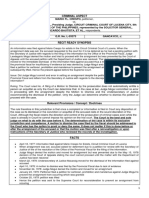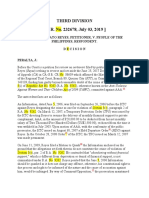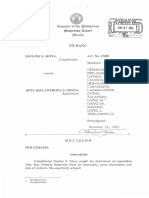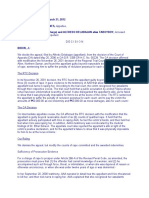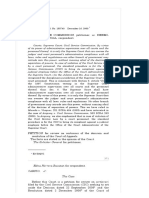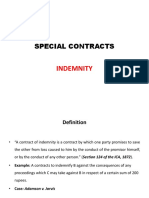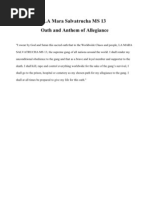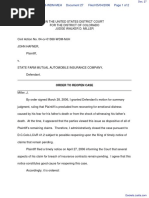0%(1)0% found this document useful (1 vote)
105 viewsA Time To Kill
A Time To Kill
Uploaded by
Angela IngenieroThe document provides an analysis of the movie "A Time to Kill" and how it highlights issues of racism in the American criminal justice system. Specifically, it discusses how the prosecutor in the movie seems to manipulate the case and favor white Americans at the expense of Carl Lee Bailey, who is black, getting a fair trial after killing the men who raped his daughter. The document argues that the prosecutor tries to dismiss empathy and only focus on a black-and-white view of the law, avoiding true justice. It concludes that for justice to prevail, the criminal justice system needs to consider all aspects of a case rather than just influential rule-based reasoning.
Copyright:
© All Rights Reserved
Available Formats
Download as PDF, TXT or read online from Scribd
A Time To Kill
A Time To Kill
Uploaded by
Angela Ingeniero0%(1)0% found this document useful (1 vote)
105 views2 pagesThe document provides an analysis of the movie "A Time to Kill" and how it highlights issues of racism in the American criminal justice system. Specifically, it discusses how the prosecutor in the movie seems to manipulate the case and favor white Americans at the expense of Carl Lee Bailey, who is black, getting a fair trial after killing the men who raped his daughter. The document argues that the prosecutor tries to dismiss empathy and only focus on a black-and-white view of the law, avoiding true justice. It concludes that for justice to prevail, the criminal justice system needs to consider all aspects of a case rather than just influential rule-based reasoning.
Original Description:
This file is a summary of the movie 'A time to kill'.
Original Title
A TIME TO KILL
Copyright
© © All Rights Reserved
Available Formats
PDF, TXT or read online from Scribd
Share this document
Did you find this document useful?
Is this content inappropriate?
The document provides an analysis of the movie "A Time to Kill" and how it highlights issues of racism in the American criminal justice system. Specifically, it discusses how the prosecutor in the movie seems to manipulate the case and favor white Americans at the expense of Carl Lee Bailey, who is black, getting a fair trial after killing the men who raped his daughter. The document argues that the prosecutor tries to dismiss empathy and only focus on a black-and-white view of the law, avoiding true justice. It concludes that for justice to prevail, the criminal justice system needs to consider all aspects of a case rather than just influential rule-based reasoning.
Copyright:
© All Rights Reserved
Available Formats
Download as PDF, TXT or read online from Scribd
Download as pdf or txt
0%(1)0% found this document useful (1 vote)
105 views2 pagesA Time To Kill
A Time To Kill
Uploaded by
Angela IngenieroThe document provides an analysis of the movie "A Time to Kill" and how it highlights issues of racism in the American criminal justice system. Specifically, it discusses how the prosecutor in the movie seems to manipulate the case and favor white Americans at the expense of Carl Lee Bailey, who is black, getting a fair trial after killing the men who raped his daughter. The document argues that the prosecutor tries to dismiss empathy and only focus on a black-and-white view of the law, avoiding true justice. It concludes that for justice to prevail, the criminal justice system needs to consider all aspects of a case rather than just influential rule-based reasoning.
Copyright:
© All Rights Reserved
Available Formats
Download as PDF, TXT or read online from Scribd
Download as pdf or txt
You are on page 1of 2
Submitted by: Angela Mae M.
Ingeniero
Bachelor of Arts in Political Science 2-A
Criminal Law: An analysis paper to the movie “A time to kill”
A time to kill is one of the movies that highlighted the whole issue of racism and discrimination as it
happened in ancient American society. Racial prejudice also happens even to powerful systems in
society such as the judiciary. The actions of the prosecutor, for instance, tend to change between two
decisions, the initial decision that Tonya's father is guilty of revenge and the other decision that actually,
carl Bailey was justified to revenge for his daughter since the compromised judicial system could have
easily let the suspect enjoy their freedom despite what happened.
In his submission, the prosecutor portrays carl Lee Bailey as an unruly character who doesn’t care about
the law of the land, a case of insanity. His plea is that Tonya's father had committed a serious felony that
requires no other punishment other than the death penalty. In fact, as a lawyer, the prosecutor has all
that it takes to convince and influence the final verdict of the case. He doesn’t show any emotions even
towards a suffering young girl who was forcefully raped and almost murdered. The irony, in this case, is
that the court has set the perpetrators free.
According to the prosecutor, nothing whatsoever can justify carl's actions of shooting the two suspects.
In fact, to a great extent, the submissions of the prosecutor influence the presiding judges ruling to deny
Brigance change of venue. In an open court system, the prosecutor tends to manipulate the entire
system to believe that blacks, such as carl lee should be extremely punished for nay, the offense they
commit, regardless of the circumstances, while the same law should be loosed when it comes to
prosecuting white offenders.
The prosecution defense as presented in the movie is likely to hinder the justice to Tonya, a victim of
rape, and attempted murder. The trial, in this case, seemed to be inclined towards upholding the
prosecutor’s version of the care, especially during the preliminary hearing. However, the prosecution
trial attorney was quick to note the genuine facts in the submissions of Carl's attorney. For instance, it is
the cross-examination of the lawyer that changed the fate of the case. While it was initially destined to
fail, the truth witness story as narrated by Brigance brought in emotions that prompted the attorney
who overruled the submissions of the prosecutor.
In conclusion, the decision of the prosecutor tends to compromise the entire effect of the criminal
justice system. While he is expected to remain impartial and submit facts, the prosecution in this movie
seems to have a racially determined, a move that further fuels the animosity between white and black
Americans. He seems to favor the white Americans at the expense of a free and fair trial. As a result,
therefore, there’s little hope that due justice will prevail in such a system. For instance, such prejudiced
prosecutions can easily grant impeachment of office bearers where is no reason or even authorize
unfounded sequestration. The summation of the evidence set the convicted free of any guilt and
contempt if the court and thus the objection by his lawyers were listened to and acted upon.
The law is thought to provide justice in a way that deals out proper punishment to correspond to a
committed crime; but, to create and ensure justice, the law needs to personify each case in it’s entirety
rather than to try and dismiss empathy's role in the decision-making process of the jury. The law puts
too much emphasis on cases being black-and-white, and this movie demonstrates that in more ways
than one. When the law doesn’t take into account the gray areas, justice is avoided, and the real victims
can be left feeling despondent and belittle. It is important to realize that the criminal-victim roles that
exist in the court can be morally reversed. Such a realization results in a situation that requires more
than an influential rule-based system to come to a verdict that not only maintains the integrity of the
law but also corresponds with the morale of the community.
Throughout the movie, and in a broader context can easily be applied to societies where socio-legal
discrimination is still prevalent against racial minorities.
You might also like
- Canadian Charter Rights Freedoms EngDocument1 pageCanadian Charter Rights Freedoms EngRyanNo ratings yet
- Present Interest ChartDocument2 pagesPresent Interest ChartpowellpmNo ratings yet
- A Time To Kill: The Thin Line Between Law and EmpathyDocument3 pagesA Time To Kill: The Thin Line Between Law and EmpathyGem AusteroNo ratings yet
- Criminal Aspect: Rojas, Godfred BenjaminDocument2 pagesCriminal Aspect: Rojas, Godfred BenjaminadeeNo ratings yet
- GTZ v. CA April 16, 2009Document2 pagesGTZ v. CA April 16, 2009ArielNo ratings yet
- Jurisdiction - Laude Vs Ginez-Jabalde, GR No. 217456, 24 November 2015Document1 pageJurisdiction - Laude Vs Ginez-Jabalde, GR No. 217456, 24 November 2015Apple LavarezNo ratings yet
- Alfredo Cuyos Vs Honorable Nicolas GarciaDocument1 pageAlfredo Cuyos Vs Honorable Nicolas GarciaAntoniette Maria LuceroNo ratings yet
- (G.R. No. 232678, July 03, 2019) Donato Reyes VawcDocument12 pages(G.R. No. 232678, July 03, 2019) Donato Reyes VawcFlorenz Efren CacatianNo ratings yet
- Chavez Vs JBC en Banc G.R. No. 202242 April 16, 2013Document29 pagesChavez Vs JBC en Banc G.R. No. 202242 April 16, 2013herbs22225847No ratings yet
- Velarde v. Social Justice Society, GR No 159357, 2004Document17 pagesVelarde v. Social Justice Society, GR No 159357, 2004TheodoreJosephJumamilNo ratings yet
- Baguilat V Alvarez (G.R. No. 227757)Document3 pagesBaguilat V Alvarez (G.R. No. 227757)ellavisda100% (1)
- ( (:ourt: UprcutrDocument21 pages( (:ourt: UprcutrKyla Ellen CalelaoNo ratings yet
- 10 Sayson vs. PeopleDocument1 page10 Sayson vs. PeopleHenri VasquezNo ratings yet
- Philo Q&A (Philosophy of Law)Document6 pagesPhilo Q&A (Philosophy of Law)libralanxaustralisNo ratings yet
- PP VS LascanoDocument4 pagesPP VS Lascanomaria lourdes lopenaNo ratings yet
- People V PantojaDocument2 pagesPeople V PantojaJozele DalupangNo ratings yet
- Guingona V GonzalesDocument2 pagesGuingona V GonzalesRR FNo ratings yet
- Consti Law (Midterm Exam)Document2 pagesConsti Law (Midterm Exam)Kriztine MirasolNo ratings yet
- Bondoc V PinedaDocument3 pagesBondoc V PinedaMike KryptoniteNo ratings yet
- Ministerio DigestDocument2 pagesMinisterio DigestMelca PeruNo ratings yet
- 2016 BarDocument7 pages2016 BarJames CENo ratings yet
- Pormento Vs EsteradaDocument21 pagesPormento Vs EsteradaAcad CARTCNo ratings yet
- Cases CompilationDocument18 pagesCases CompilationTricia GrafiloNo ratings yet
- Rule of Action Law - Is Any Rule of Action or Order of Sequence From Which Any Beings WhatsoeverDocument12 pagesRule of Action Law - Is Any Rule of Action or Order of Sequence From Which Any Beings WhatsoeverAerith AlejandreNo ratings yet
- Brion, Jr. vs. Brillantes, Jr. Admin Case No. 5305, March 17, 2003Document6 pagesBrion, Jr. vs. Brillantes, Jr. Admin Case No. 5305, March 17, 2003Ronald Jay GopezNo ratings yet
- 34 G.R. No. 102667 Lansang vs. CADocument2 pages34 G.R. No. 102667 Lansang vs. CAStephanie LaderoNo ratings yet
- Case DigestDocument3 pagesCase DigestAlbert AgnesNo ratings yet
- 2 Aspa Sayson Vs PPLDocument1 page2 Aspa Sayson Vs PPLgutierrez.grace1234No ratings yet
- Lapitan V PcsoDocument7 pagesLapitan V PcsonineballwhiteglintNo ratings yet
- COMPAGNIE FRANCO-INDOCHINOISE, Plaintiff-Appellant, vs. DEUTSCH-AUSTRALISCHE DAMPSCHIFFS GESELLSCHAFT, Defendant-AppellantDocument12 pagesCOMPAGNIE FRANCO-INDOCHINOISE, Plaintiff-Appellant, vs. DEUTSCH-AUSTRALISCHE DAMPSCHIFFS GESELLSCHAFT, Defendant-AppellantKai100% (1)
- Republic v. SandiganbayanDocument2 pagesRepublic v. SandiganbayanTrisha Ortega100% (1)
- Neri v. SenateDocument9 pagesNeri v. SenateBAROPS100% (1)
- sara duterte fillerDocument2 pagessara duterte fillerJamze MontealtoNo ratings yet
- Case Digest Mendez Vs MaligaDocument2 pagesCase Digest Mendez Vs MaligaGene AdionNo ratings yet
- 345 Amante Roa V Insular Collector of CustomsDocument1 page345 Amante Roa V Insular Collector of CustomsCarissa CruzNo ratings yet
- Cabarroguis Vs BasaDocument9 pagesCabarroguis Vs BasaMark John Geronimo BautistaNo ratings yet
- Funa vs. COADocument2 pagesFuna vs. COARuth LumibaoNo ratings yet
- Biraogo vs. The Philippine Truth Commission (G.R. No. 192935, December 7, 2010)Document2 pagesBiraogo vs. The Philippine Truth Commission (G.R. No. 192935, December 7, 2010)Joshua BacarroNo ratings yet
- University of San Agustin v. CADocument3 pagesUniversity of San Agustin v. CARaynold deltaNo ratings yet
- Pamatong vs. COMELECDocument1 pagePamatong vs. COMELECMitch TinioNo ratings yet
- Province of North Cotabato V Republic of The PhilippinesDocument25 pagesProvince of North Cotabato V Republic of The PhilippinesJm BrjNo ratings yet
- G.R. No. 1455 - in Re AllenDocument13 pagesG.R. No. 1455 - in Re AllenRichie SalubreNo ratings yet
- SULPICIO INTOD v. CA, GR No. 103119, 1992-10-21Document11 pagesSULPICIO INTOD v. CA, GR No. 103119, 1992-10-21Ken BaxNo ratings yet
- 183 Guerrero vs. COMELEC DigestDocument2 pages183 Guerrero vs. COMELEC DigestAMIDA ISMAEL. SALISANo ratings yet
- Module 4-22 Republic vs. Villasor (G.R. No. L-30671, November 28, 1973)Document3 pagesModule 4-22 Republic vs. Villasor (G.R. No. L-30671, November 28, 1973)mee tooNo ratings yet
- Leonen Dissent DigestDocument2 pagesLeonen Dissent DigestJeremy MorenoNo ratings yet
- Del Mar v. PAGCOR Et. Al., GR No. 138298, November 29, 2000Document5 pagesDel Mar v. PAGCOR Et. Al., GR No. 138298, November 29, 2000Judy Anne RamirezNo ratings yet
- 138 Osmeña vs. Pendatun 109 PHIL 863 (1960)Document2 pages138 Osmeña vs. Pendatun 109 PHIL 863 (1960)triciaNo ratings yet
- 64 Consti 1 - Art VI Board of Canvassers - 2 Pimentel V Joint Commitee of CongressDocument2 pages64 Consti 1 - Art VI Board of Canvassers - 2 Pimentel V Joint Commitee of CongressJanmari G. FajardoNo ratings yet
- G.R. No. 4963 (US V Go Chico)Document5 pagesG.R. No. 4963 (US V Go Chico)KhiarraNo ratings yet
- Mansanto Vs Factoran GR No. 78239 Feb 9, 1989Document2 pagesMansanto Vs Factoran GR No. 78239 Feb 9, 1989Aldrin MoralesNo ratings yet
- En Banc (G.R. No. 163556, June 08, 2004)Document65 pagesEn Banc (G.R. No. 163556, June 08, 2004)Paulyn MarieNo ratings yet
- Criminal Law Book1Document142 pagesCriminal Law Book1HyviBaculiSaynoNo ratings yet
- Rufino v. EndrigaDocument1 pageRufino v. EndrigaRica RodriguezNo ratings yet
- In Re ShoopDocument31 pagesIn Re ShoopNenita Wella Jose AguilarNo ratings yet
- Just Mercy A Story of Justice and Redemption Summary AssignmentDocument2 pagesJust Mercy A Story of Justice and Redemption Summary Assignmentapi-544330083No ratings yet
- CSC Vs AndalDocument7 pagesCSC Vs AndalMaxxNo ratings yet
- 33 Mamba V Lara G R No 165109Document2 pages33 Mamba V Lara G R No 165109PaulRuizNo ratings yet
- Garcia, Et Al. v. People - 318 SCRA 434Document5 pagesGarcia, Et Al. v. People - 318 SCRA 434Khenz MistalNo ratings yet
- A Time To KillDocument3 pagesA Time To KillMary grace ApostolNo ratings yet
- Legal RealismDocument4 pagesLegal RealismGahna RajaniNo ratings yet
- The Case of The Speluncean ExplorersDocument6 pagesThe Case of The Speluncean ExplorersVirginia Perez JimenezNo ratings yet
- Unit 1 - IndemnityDocument19 pagesUnit 1 - IndemnityHarsh GargNo ratings yet
- Same Sex Marriage Pro ConDocument2 pagesSame Sex Marriage Pro ConSofia AlcatracesNo ratings yet
- Article Submission For Publication in MANUPATRA 2021Document6 pagesArticle Submission For Publication in MANUPATRA 2021Mohd ArhamNo ratings yet
- SPL EXAM AnswerDocument6 pagesSPL EXAM AnswerRain Guiling MacodNo ratings yet
- Newtech V State of UP RERADocument45 pagesNewtech V State of UP RERAvasu.181900No ratings yet
- The Tax Disputes and Litigation Review: Law Business ResearchDocument26 pagesThe Tax Disputes and Litigation Review: Law Business ResearchJoefrey UyNo ratings yet
- Tolentino v. Sec. of FinanceDocument2 pagesTolentino v. Sec. of FinanceChou TakahiroNo ratings yet
- Writ of MandamusDocument2 pagesWrit of MandamusRocky John Tayaban100% (1)
- Christian Solidarity Party Letter To TD's and SenatorsDocument2 pagesChristian Solidarity Party Letter To TD's and SenatorsSuzy ByrneNo ratings yet
- GRATUTITY ACT An Act To Provide For A Scheme For The Payment of Gratuity ToDocument3 pagesGRATUTITY ACT An Act To Provide For A Scheme For The Payment of Gratuity TovaidehiNo ratings yet
- Management Prerogatives CompilationDocument21 pagesManagement Prerogatives CompilationRap SantosNo ratings yet
- You Must Obtain A Certificate of ClearanceDocument2 pagesYou Must Obtain A Certificate of ClearanceNadine Bär-SchmitzNo ratings yet
- Philippines Downplays Sultan Heirs' Sabah Claims As Private'Document7 pagesPhilippines Downplays Sultan Heirs' Sabah Claims As Private'ay mieNo ratings yet
- Obama Administration Memorandum Mandating "Diversity" Training To Teach "Intersectionality"Document7 pagesObama Administration Memorandum Mandating "Diversity" Training To Teach "Intersectionality"ThePoliticalHatNo ratings yet
- LA Mara Salvatrucha MS 13 Oath and Anthem of AllegianceDocument1 pageLA Mara Salvatrucha MS 13 Oath and Anthem of AllegianceEugene KowalzkiNo ratings yet
- Defendant's Answer To Second Amended Complaint, Tara Walker Lyons v. Larry Atchison Et Al, Case No. DV 2016-547, Lewis and Clark County, MT, 4/16/18Document5 pagesDefendant's Answer To Second Amended Complaint, Tara Walker Lyons v. Larry Atchison Et Al, Case No. DV 2016-547, Lewis and Clark County, MT, 4/16/18Peter M. HeimlichNo ratings yet
- Liens On CargosDocument2 pagesLiens On CargosMaria Paula BlainNo ratings yet
- Leo - Wanta - RICO STATUTES Vs Obama Biden Administration - 31 PDFDocument31 pagesLeo - Wanta - RICO STATUTES Vs Obama Biden Administration - 31 PDFKauilapeleKona100% (3)
- Roy Pasos v. Philippine Nation Construction CorporationDocument3 pagesRoy Pasos v. Philippine Nation Construction Corporationsnhlao100% (1)
- Dkt. 144 Re Caroline Ellison's USSG 5k.1 Cooperation Agreement.Document4 pagesDkt. 144 Re Caroline Ellison's USSG 5k.1 Cooperation Agreement.Thomas WareNo ratings yet
- GO Ms - No178 DA 04.07.2012Document8 pagesGO Ms - No178 DA 04.07.2012Narasimha SastryNo ratings yet
- Non Disclosure Agreement Kvell 9818384760 WWW - KVELLCO.CODocument2 pagesNon Disclosure Agreement Kvell 9818384760 WWW - KVELLCO.COCA Sudhanshu Joshi50% (2)
- Western Times English 01-05Document2 pagesWestern Times English 01-05sivarajNo ratings yet
- Business Law 2Document20 pagesBusiness Law 2Manan SharmaNo ratings yet
- CPC - Relevance of Documents Primary Consideration Before Allowing Order XI Rule 12 Application - J&K High CourtDocument18 pagesCPC - Relevance of Documents Primary Consideration Before Allowing Order XI Rule 12 Application - J&K High CourtVanshika GuptaNo ratings yet
- Tulsidas Letter of AdministrationDocument25 pagesTulsidas Letter of AdministrationShubham SarkarNo ratings yet
- Hafner, Et Al v. State Farm Ins Co - Document No. 27Document2 pagesHafner, Et Al v. State Farm Ins Co - Document No. 27Justia.comNo ratings yet



